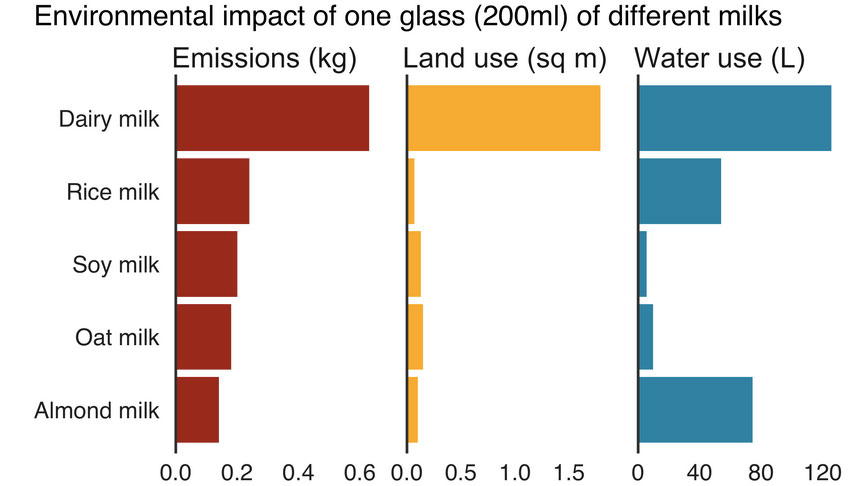The popularity of plant-based milk has been growing. Among them, we can find almond milk – which is increasingly found everywhere from coffee-shops to restaurants and supermarket shelves. But is almond milk really more sustainable than dairy milk or other plant-based types of milk like soy, oat, or rice? Is almond milk bad for the environment?
The Plant-Based Milk Market Is Growing And Gaining Momentum – Especially Almond Milk
According to Arizton Advisory and Intelligence, the number of people becoming more conscious about their health and choosing a healthier diet is rising. Either because of personal preferences, allergies, lactose-intolerance (which affects 60% of the world’s population), other diet restrictions, or due to environmental concerns, the demand for dairy-free products is on the rise.
Either to be mixed with coffee, added to porridge, cereal bowls, smoothies, or pancakes, plant-based milk is becoming trendier – especially almond milk. In fact, the demand for the latter surpassed the demand for soy milk in North America in 2018. In the same year, the plant-based beverage industry was estimated to be worth over $16 billion, according to Innova Market Insights. According to PRNews, since then until 2023, the market is expected to grow by over US$12 billion – with almond-based dairy alternatives making up the quickest growing sector.
It is often only after getting a new habit, in this case, a new favorite beverage, that we realize its true implications. Let’s understand better what is happening behind the scenes – and why almond milk might not be as sustainable as we might think at first. In fact, is it possible that almond milk is actually bad for the environment?
Assessing The Environmental Impact Of Milk Production Is Complex
An LCA stands for lifecycle analysis. In short, an LCA is meant to estimate the environmental impacts of a product or service. In order to do this, they assess a series of impacts across the value chain. If these impacts go until the end of the production, the analysis is usually named cradle-to-gate. If it spreads until the end of the lifecycle (for instance, how products are dealt with once they are discarded) it is then called a cradle-to-cradle assessment.
In this way, analyzing a product’s environmental footprint means assessing variables such as greenhouse gas emissions, land and/or water use, or soil degradation. For instance, a study from Kendal et. al. (2019) trying to evaluate the impact of 1l of almond milk uses impact categories such as global warming potential (GWP), renewable and non-renewable total primary energy use, freshwater consumption or human toxicity potential.
One of the things making it hard to compared different plant-based types of milk among them and with dairy milk is that brands use different processes, modeling assumptions, and impact methodologies. This makes it harder to get a one-size-fits-all average number for the production of each type of milk that would make comparisons easier. Moreover, at this stage, there are not a lot of plant-based milk studies able to provide a wider range of conclusions. Still, some impact assumptions can be drawn with a high level of confidence regarding whether or not almond milk is bad for the environment.
Is Almond Milk Bad For The Environment In California?
Where does almond milk come from? Perhaps not surprisingly, 80% of the world’s commercial almond production comes from California, with the US accounting for the production of 1034.10 thousand metric tonnes of almonds in 2018/2019. According to CDFA, almond crops occupy around 1% of the total land area of the Eldorado state, or 11% of its irrigated cropland.
As usual (same with palm-oil, coffee or avocados), the high demand for a commodity ends up creating a monoculture to make crops more profitable. And it does not matter where or of which species, monocultures are hardly positive. In the short-term, they are economically interesting and allow for intensive productions that can supply many people. But in the medium-long term, it means less ecosystem resistance to plagues and soil depletion as the ground loses its variety of nutrients.
In fact, since intensive almond cultures demand huge amounts of water and almond nuts usually have a larger water footprint compared to other kinds of milk. For instance, studies show almond milk spends almost 20 times more water than dairy milk (though the latter performs worse on GHG emissions). In fact, a recent study estimated the total water footprint for one California almond is on average 3.2 gallons (128L). Ultimately, the large concentration of these thirsty nuts contributes to the serious drought conditions the region of California is frequently facing. From this perspective, the production of almond milk can be considered harmful and bad for the environment.
The Bad Environmental Impact Of Almond Milk Production
From the US to the world, according to Statistica, Europe is the second-largest producer of almond nuts. Within the EU, the Global Agricultural Information Network says Spain (71,622 thousand metric tonnes in 2018) and Italy (12,800 thousand metric tonnes in 2018) are the largest producers. Following the data from FAO, other countries such as Tunisia, Morocco, Portugal Greece have significant productions too. In many of these countries, drought situations have been or are expected to soon be a problem too.
Across all these different locations, and of course, varying according to the production and consumption locations, almond milk seems to have a better (smaller) overall impact compared to dairy milk. For instance, one study says the US average GWP (global warming potential) for dairy milk is 4.5 times the size of the GWP for almond milk. Another study also notes the smaller carbon impact of almond milk (0.36 kg/l) milk compared to whole dairy milk (1.6kg/l).
The environmental impact of dairy milk is mostly the result of producing
raw milk. These cradle-to-gate impacts are mostly caused by the famous pollution associated with intensive livestock farming. Some of the most known ones are the deforestation (and pollution via fertilizers) caused to grow soy, its transportation emissions until they get to the cattle and (especially) cows’ methane “discharges”. The dairy industry accounts for 4% of men-caused GHG, according to FAO.
However, a study has shown the carbon footprint of cow’s milk can be significantly reduced if sustainable livestock farming based on pasture. Since cows are fed on grass rather than on cereals, soybeans and oilseeds, all the environmental impacts linked to the production of ruminant food disappear.
On Water Consumption, Almond Milk Is Bad For The Environment
As we’ve briefly mentioned above, almond’s good environmental reputation gets further threatened when it comes to water consumption. A study showed an average US freshwater consumption of 307 L per 48 oz for whole milk, compared to 175 L per 48 oz. for unsweetened almond milk.
Another one ended up with having a similar conclusion: almond milk production uses around 17 times more water than cow milk production per liter. Overall, LCAs tend to indicate that while almond milk is more water-intensive, cow milk is a heavier CO2 polluter.
The other problem with almond milk is that it leads to the loss of a large part of the almonds’ nutrients. To produce almond milk manufacturers are left with an almond pulp byproduct. Despite this pulp is rich in fibers and other nutrients, it is, at least for now, hard to reuse in as part of a different product. So when comparing almond and dairy milk, studies concluded the properties of the latter are challenging to replace. Does this mean almond milk is bad for the environment?
Is Plant-Based Almond Milk Environmentally Bad? It’s Complex

Almonds taste great, and so does almond milk (let’s be fair about it). Either roasted or raw, this is an incredibly tasty nut. So nice that is the second most nut consumed worldwide (only behind peanuts). However, as usual, the promises of green consumerism (which is still consumerism!) is leading to the growth of new markets. And these markets aren’t always as sustainable as we are told.
When it comes to almond milk, its high water consumption (and consequent droughting effect) means it is harmful to the environment. If you consume it away from its main producing countries, its impact is even higher due to emissions associated with transportation. When choosing between almond and dairy milk, the question can even be placed from a perspective of choosing to advocate for climate change (choosing almonds) or water scarcity.
However, choosing from brands adopting sustainable methods of raising cattle or that using agroecological methods of irrigating water into California’s almond crops is a way of helping reduce the impacts of both types of milk. And the only way of knowing is to ask brands to show better proof of their CSR strategies along with their CSR reports and impacts.
Sure there are other options, which we haven’t analyzed with much detail in this piece. But while they perform better on some impact indicators, they do worst on others. For instance, rice milk uses less water than almond milk, but it is worse regarding emissions. In fact, a study on greenhouse gas emissions from rice crops says rice is one of the largest sources of methane emissions in the world, ahead of ruminants and livestock. The same pros and cons happen with oat, soy or even goat milk.
When it comes to sustainable consumption, the reality is complex and there are many variables to take into consideration. You should find time to learn about them, and that’s what Youmatter is here for. But don’t be too hard on yourself either. Ending with Rachel Hosie’s words, who also wrote an essay about plant-based kinds of milk: “At the end of the day, the fact that you’re thinking about your environmental impact is to be applauded, so don’t beat yourself up for trying to make a perfect choice — there’s no such thing.“
[Image credits to almonds on Shutterstock]

